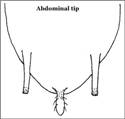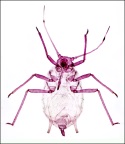Classification
Aphidinae: Aphidini
Common name(s)
Pomegranate aphid
Diagnosis
Small yellowish-green aphids typically colonizing the upper sides of mature leaves of pomegranate, concentrated along the midribs and around the leaf margins; also found on flowers and, rarely, fruits. All the segments of antennae pale except processus terminalis, which is dusky. Siphunculi and cauda concolourous with body. Siphunculi are usually pale on basal half and apically darker. Legs pale with tarsi dusky to dark. Antenna almost half the length of body. Antennal segment III usually as long as siphunculi.
Aphis achyranthi Theobald occurs on the same host plant (pomegranate), but can be differentiated from A. punicae by the dark brown siphunculi and cauda, which are concolorous in the latter.
Distribution
Throughout the Mediterranean region, Middle East, Ethiopia, India (Karnataka; Meghalaya; Tamil Nadu; West Bengal), Pakistan.
Host plant(s)
Punicaceae: Punica granatum Linn.
Measurements
Aptera: Length of body 1.60, width 0.89; antennae 0.81, segments III: IV: V: VI 0.21: 0.12: 0.13: (0.09+0.17); u.r.s. 0.10; h.t.2 0.08; siphunculus 0.21; cauda 0.13.
Alata: Length of body 1.59, width 0.61; antennae 0.79, segments III: IV: V: VI 0.24: 0.16: 0.15: (0.11+0.23); u.r.s. 0.10; h.t.2 0.09; siphunculus 0.21; cauda 0.10.
Seasonal occurrence
June-August in and around Bangalore; January, November.
Natural enemies
Coleoptera: Coccinellidae: Coccinella undecimpunctata L., Scymnus (Pullus) castaneus Sicard, S. (P.) coccivora Ayyar, S. (P.) latemaculatus Motschulsky.
Diptera: Syrphidae: Ischiodon scutellaris (F.).
_sml.jpg)
_sml.jpg)
_sml.jpg)
_sml.jpg)
_sml.jpg)

_sml.jpg)
_sml.jpg)
_sml.jpg)
_sml.jpg)

